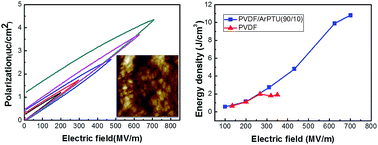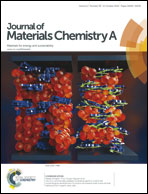High-energy-density dielectric films based on polyvinylidene fluoride and aromatic polythiourea for capacitors†
Abstract
To improve the dielectric performance of polyvinylidene fluoride (PVDF), blend films based on PVDF and aromatic polythiourea (ArPTU) were prepared by the solution casting method. The blend films have higher dielectric constant (9.2) and lower loss at low fields (0.02 at 1 kHz) than a pure PVDF film (8.4, 0.05 at 1 kHz). More importantly, the blend films can also inhibit the early polarization saturation at low fields and result in the significant enhancement of the dielectric strength and increase in the energy density and reduction of loss at high fields. For the PVDF/ArPTU(90/10) film, the maximum operating electric field is about 700 MV m−1 and the released energy density can be up to 10.8 J cm−3 with an efficiency of above 83%. The X-ray diffraction data and atomic force microscopy images show that these blend films exhibit clear structural changes with an increasing percentage of ArPTU. It is proven that the increase of the β phase content and decrease of the crystalline grains in blend films are helpful to reduce the dielectric loss and enhance the dielectric strength.


 Please wait while we load your content...
Please wait while we load your content...